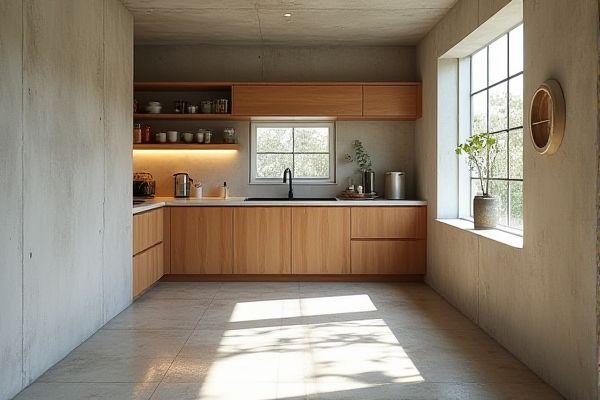
Concrete pantry floors offer durability and easy maintenance, perfect for heavy use and resisting stains or moisture, while tiled pantry floors provide aesthetic variety with endless design options and better slip resistance. Explore the rest of the article to discover which flooring choice best suits your pantry's needs and style preferences.
Table of Comparison
| Feature | Concrete Pantry Floor | Tiled Pantry Floor |
|---|---|---|
| Durability | Highly durable, resists cracks and heavy loads | Durable but grout can wear or crack over time |
| Maintenance | Low maintenance; requires occasional sealing | Requires regular cleaning and grout sealing |
| Cost | Generally lower cost, especially if existing slab used | Higher cost due to materials and installation |
| Installation Time | Fast installation, can be poured and set quickly | Longer installation due to tile placement and grout drying |
| Appearance | Industrial, minimalistic look; can be stained or polished | Wide variety of designs, colors, and textures available |
| Slip Resistance | Can be slippery when wet unless textured | Can be slip resistant depending on tile choice |
| Comfort | Hard and cold underfoot | Varies; some tiles offer warmth and softness |
| Water Resistance | Excellent, especially when sealed properly | Good water resistance; grout areas require sealing |
Overview: Concrete vs Tiled Pantry Floors
Concrete pantry floors offer durability, low maintenance, and a modern industrial aesthetic, making them ideal for high-traffic areas prone to spills and heavy use. Tiled pantry floors provide design versatility with a wide range of colors, patterns, and textures, enhancing your pantry's visual appeal while offering easy cleaning and resistance to moisture. Your choice depends on balancing the sturdy practicality of concrete with the customizable style and surface variety that tile flooring delivers.
Durability Comparison: Concrete and Tile
Concrete pantry floors offer superior durability due to their resistance to heavy foot traffic, impacts, and moisture, making them ideal for long-lasting use in pantry areas. Tiled pantry floors, while durable and resistant to stains and scratches, can be prone to cracking or chipping under heavy loads or sudden impacts. Both materials provide excellent longevity, but concrete generally outperforms tile in terms of toughness and resistance to wear over time.
Maintenance Requirements
Concrete pantry floors require minimal maintenance, needing only occasional sweeping and mopping to prevent dust buildup and stains, and can be resealed periodically to maintain durability and moisture resistance. Tiled pantry floors demand regular grout cleaning and monitoring for cracks or chips, as grout can harbor dirt and mold if not properly sealed and maintained. Both floors benefit from prompt spill cleanup to avoid staining, but concrete generally offers a more resilient, low-maintenance surface compared to tile.
Aesthetic Appeal and Design Flexibility
Concrete pantry floors offer a sleek, modern aesthetic with customizable stains, textures, and patterns that create a seamless look adaptable to various design styles. Tiled pantry floors provide diverse color, shape, and material options, allowing intricate designs and vibrant patterns that enhance traditional or eclectic interiors. Your choice depends on whether you prefer the minimalist, industrial charm of concrete or the versatile, decorative possibilities of tile.
Cost Analysis: Installation and Materials
Concrete pantry floors typically cost less than tiled floors due to lower material prices and faster installation times, with concrete averaging $3 to $7 per square foot compared to tile's $5 to $15 per square foot. Installation of concrete involves pouring and finishing, which reduces labor expenses, while tiled floors require precise cutting, grouting, and potential subfloor preparation, increasing overall labor costs. Your choice impacts budget significantly as concrete offers durability and affordability, whereas tile provides greater design variety at a higher price point.
Comfort Underfoot
Concrete pantry floors provide excellent durability but tend to feel hard and cold underfoot, making them less comfortable for extended standing periods. Tiled pantry floors, especially when using materials like ceramic or porcelain with textured or matte finishes, offer enhanced comfort by providing slight cushioning and warmer touch. Incorporating rugs or mats on tiled floors can further improve comfort, balancing durability with a softer walking surface.
Moisture and Stain Resistance
Concrete pantry floors offer superior moisture resistance due to their non-porous surface when properly sealed, effectively preventing water infiltration and damage. Tiled pantry floors provide excellent stain resistance as glazed tiles create a protective barrier against spills and discoloration. Both flooring options require regular sealing and maintenance to sustain optimal moisture and stain resistance in high-traffic pantry environments.
Longevity and Lifespan
Concrete pantry floors boast exceptional longevity, often lasting 50 years or more with minimal maintenance due to their durability and resistance to wear. Tiled pantry floors typically have a lifespan of 15 to 30 years, depending on the quality of the tiles and grout, but are prone to cracking and grout deterioration over time. Both options offer durability; however, concrete floors provide a longer lifespan with fewer repairs.
Safety Considerations
Concrete pantry floors provide a durable, slip-resistant surface that reduces the risk of falls, even when wet or exposed to spills. Tiled pantry floors, while aesthetically versatile, can become slippery if glazed or if grout lines accumulate moisture, increasing slip hazards. Proper sealing and the use of textured or non-slip tiles enhance safety in tiled pantry floors, making both options viable with thoughtful installation and maintenance.
Choosing the Best Pantry Floor for Your Needs
Concrete pantry floors offer exceptional durability and easy maintenance, making them ideal for heavy use and moisture resistance. Tiled pantry floors provide versatile design options and greater slip resistance, enhancing aesthetics and safety in your space. Evaluating your lifestyle, budget, and cleaning preferences will help you determine whether concrete's robustness or tile's charm best suits your pantry floor needs.
 homyna.com
homyna.com